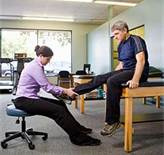PT Examination

Key elements of a physical therapy examination includes
- Cognitive or Mental status screening
- consciousness, attention, orientation, and general cognition (e.g., memory, information processing)
- Communication
- includes speech and language disorders
- Motor control
- volitional versus involuntary movements, isolated or synergistic
- Motor learning
- ability sustain motor performance over time, interpret motor feedback, transfer skills to different environments
- Postural control, balance and coordination
- Coordination
- muscle activity during voluntary movement
- muscle groups working together to perform a task (timing, accuracy, sequence) = synergy
- level of skill and efficiency
- start, control and stop according to activity/environment demand
- Gait and Locomotion
- Neuromuscular tone
- Range of Motion and Flexibility
- Integument integrity
- skin observations, pressure areas
- Pain
- Sensation and Sensory Integration
- deep tendon reflexes (DTRs)
- pathological reflex testing
- proprioception
- kinesthesia
- sensory discrimination (sharp & dull, hot & cold, vibration, light touch & pressure, right & left discrimination)
- Cranial nerve integrity
- Peripheral nerve conduction / electromyography (EMG)
- Manual Muscle Testing
- Functional Task and Mobility Analysis
- Protective and Support Equipment
- Standardized Outcome Measures
- Functional Independence Measure (FIM)
- Performance Oriented Assessment of Mobility (Tinetti)
- Functional Reach Test
- Timed Get Up and Go Test
- Timed Walking Test
- Berg Balance Scale
- Barthel Index
- Aerobic Capacity and Endurance
Summary of Patient-Client Management for Patients and Clients with Neuromuscular Conditions
- PT examination
- Review of history, reason for referral, review of systems, tests and measures, special tests, review of diagnostic studies (outcomes of imaging, lab results)
- PT Evaluation
- Interpret examination findings and apply clinical reasoning
- Considers personal and contextual factors
- Differentially diagnose and make appropriate referrals as needed for coordinating care
- PT Diagnosis
- Select practice pattern(s) that reflect a neuromuscular pattern within the scope of practice
- PT Prognosis
- Generate goals and expected outcomes; includes a plan of care (interventions, frequency, duration) to achieve goals

